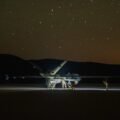The European Space Agency (ESA) has received designs for a Nuclear-Electric Propulsion (NEP) spacecraft, serving as a roadmap for the planned launch of its first mission in 2035.
Called RocketRoll (pReliminary EurOpean reCKon on nuclEar elecTric pROpuLsion for space appLications) the designs were developed by a team of contractors, including lead contractor Tractebel. According to the company, the roadmap represents the culmination of a year’s worth of work modeling and planning the cutting-edge technology that could propel future space travelers deeper into space than conventional chemical rockets.
“Thanks to its huge energy density, NEP offers disruptive advantages in terms of speed, autonomy, and flexibility,” Tractebel explained in a press release announcing the delivery of RocketRoll. “This innovative propulsion technology has the potential to transform space exploration and space mobility by enabling longer-duration missions, potentially shaping the future of interplanetary exploration.”
Since the launch of the first rockets in the 1950s, engineers have relied on chemical propellants to deliver the energy densities to leave Earth’s orbit. However, aircraft require significantly less thrust once in space to explore or even leave the solar system. While many spacecraft still rely on chemical propellants to maneuver in space, more advanced systems like ion drives have begun to use electricity to reduce the fuel required in the initial launch payload.
Other companies, such as Morpheus Space, are developing technologies that rely on solar panels to collect and convert energy, combined with an onboard propellant-like liquid metal, into thrust. NASA is also looking at ways to use electric propulsion to maneuver spacecraft more efficiently. In 2016, they announced the development of the Advanced Electric Propulsion System (AEPS), which will use solar electric propulsion (SEP) and a small amount of fuel to maneuver the upcoming Gateway mission.
“AEPS is truly a next-generation technology,” said Clayton Kachele, the AEPS project manager at NASA’s Glenn Research Center in Cleveland in 2023. “Current electric propulsion systems use around four and a half kilowatts of power, whereas here we’re significantly increasing power in a single thruster. That capability opens a world of opportunity for future space exploration, and AEPS will get us there farther and faster.”
In 2024, The Debrief first reported on a controversial new electric propulsion technology whose inventor and current NASA scientist, Dr. Charles Buhler, says requires no propellant other than electrical power. Instead, the electrostatics expert says his team has discovered a new force he calls the “Exodus Effect.”
“The most important message to convey to the public is that a major discovery occurred,” Buhler told The Debrief at the time. “This discovery of a New Force is fundamental in that electric fields alone can generate a sustainable force onto an object and allow center-of-mass translation of said object without expelling mass.”
That system has become controversial because it appears to defy Newton’s laws of motion. Buhler challenged that claim, noting that his team has shown that it can work without defying physics.
“There are rules that include conservation of energy, but if done correctly, one can generate forces unlike anything humankind has done before,” Buhler told The Debrief. “It will be this force that we will use to propel objects for the next 1,000 years… until the next thing comes.”
Until that drive is proven to work in space, mission planners who want to employ electric propulsion systems will need to rely on SEPs. However, SEPs require energy from the sun, which becomes less available the farther they travel from the source. Even spacecraft that travel beyond the moon to explore places like Mars, Jupiter, and Saturn see their energy collection abilities greatly diminish as soon as they begin to leave Earth’s orbit.
To address these and other shortcomings around energy storage, the Tractabel team, which includes the French Alternative Energies and Atomic Energy Commission (CEA), ArianeGroup, Airbus, and Frazer Nash, has focused on nuclear power’s energy-generating capabilities to fuel nuclear electric propulsion. If their designs are successful, their technology demonstrator could boast significantly more power than the most robust SEP.
According to a statement from Tractebel, their RockRoll roadmap will allow them to explore various configurations for their NEP system. This includes thermal electric generators that capture the heat from a decaying nuclear isotope to generate electricity and fission systems like those used in nuclear weapons.
“Tractebel’s strategy is to engineer a range of nuclear power solutions, from radioisotope to fission systems, while also contributing to developing a European value chain for nuclear solutions in space applications,” they explain.
Although many technological hurdles remain between now and 2035, the completion of the roadmap offers a clear path to launch. If successful, the company believes that leveraging the power of nuclear electric propulsion for longer missions deeper into space will help humanity.
“I am proud to lead such an important initiative in nuclear electric propulsion, which could enable exploration and in-space logistics in Earth Orbit and beyond on a scale that neither chemical nor electrical propulsion could ever achieve,” said Brieuc Spindler, Tractebel Project Manager and Space Product Owner.
Spindler added that he is “committed to navigating the intricate technical and strategic challenges ahead. By leveraging its nuclear expertise and innovative solutions, Tractebel helps advance space technologies and push the boundaries of the final frontier’s exploration.”
Christopher Plain is a Science Fiction and Fantasy novelist and Head Science Writer at The Debrief. Follow and connect with him on X, learn about his books at plainfiction.com, or email him directly at christopher@thedebrief.org.

